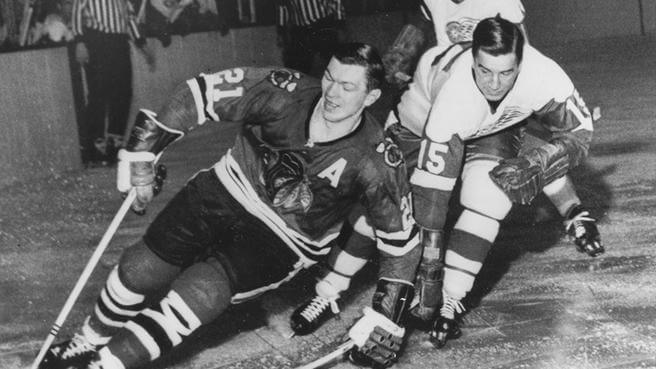
With the passing of hockey legend Ted Lindsay, surprisingly little has been written about his remarkable return to the Red Wings at age 39 after being out of the fastest sport in the world for three seasons.
You will be hard pressed to find another example in professional sports of an athlete who returned to a sport after being absent for so long and to succeed as he did.
Wings’ General Manager Jack Adams (in a stupid and vindictive move) traded the long time Wing’s captain to the Chicago Blackhawks after the ’56-’57 season because Lindsay was a leader in forming the player’s association. Lindsay had starred with the Wings for 13 seasons, helping them win seven consecutive regular season titles and four Stanley Cups. He played three seasons in Chicago and when he retired in 1960, he was the career leader in penalty minutes and goals scored by a left winger.
But Lindsay did something most former players didn’t.
When he wasn’t running his successful business with partner and former teammate Marty Pavelich he regularly worked out at Olympia Stadium and played competitive pick-up hockey three days a week at Windsor Arena.
After then Red Wing’s coach and GM Sid Abel reunited with his famous “Production Line” line mates Gordie Howe and Lindsay at a sold out Old Timer’s game at Olympia Stadium in January 1964, Abel convinced “Terrible Ted” to make a comeback.
In an interview with me for a 2005 Detroit Free Press article, Lindsay said:
“It wasn’t for the money because I was doing well, but the idea of retiring as a Red Wing was very attractive.”
Commissioner Clarence Campbell, who previously had numerous run-ins with Lindsay, called his comeback “a black day for the NHL.”
A record opening night crowd of 14,323 jammed Olympia Stadium and saw Lindsay skate out to a standing ovation that lasted several minutes.
“It sure made me feel that I must have done something right in my career that they still felt that way,” Lindsay said. “Those were my fans, my people.”
Although the Wings lost 5 to 3, and though Lindsay didn’t score, he did receive a 10-minute misconduct penalty in the second period for fighting with Tim Horton. By season’s end “Terrible Ted” accumulated 173 penalty minutes, four behind the league leader Carl Brewer.
For most of the season Lindsay played on a line with and tutored, 23-year old Bruce MacGregor and 21-year old Pit Martin. “For me Teddy was the one who turned my career around,” said MacGregor.
By winning 25 of their last 39 games the Wings won their first league championship since Lindsay was traded to Chicago. Remarkably, Lindsay played in 69 of 70 regular season games finishing with 14 goals and 14 assists. “Without question Ted was a big part of our success in winning the league championship,” MacGregor said in 2005.
Although the Wings lost to Chicago in the Stanley Cup semi-finals, what Lindsay and the Wings had done that ’64-’65 campaign was impressive.
Four months after the season had begun Commissioner Campbell issued a public apology for his shot across the bow at Lindsay’s return.
“This is one of the most amazing feats in professional sport. Lindsay has done what I thought was next to impossible. I, like many others, thought the game would suffer if a man of nearly 40 years of age could come back after being out so long. He has to be rated an amazing athlete.”
Although Lindsay had told Abel he would decide just before training camp whether he would play another season, that possibility became moot when Toronto’s Punch Imlach claimed Lindsay on waivers before the ’65-’66 season.
“Imlach knew damn well I would never play for [the] Leafs,” said Lindsay. “He was just trying to screw me. But the good Lord has always worked well for me and who knows, maybe if I had played I would [have] gotten seriously injured. Either way I was very happy.”


